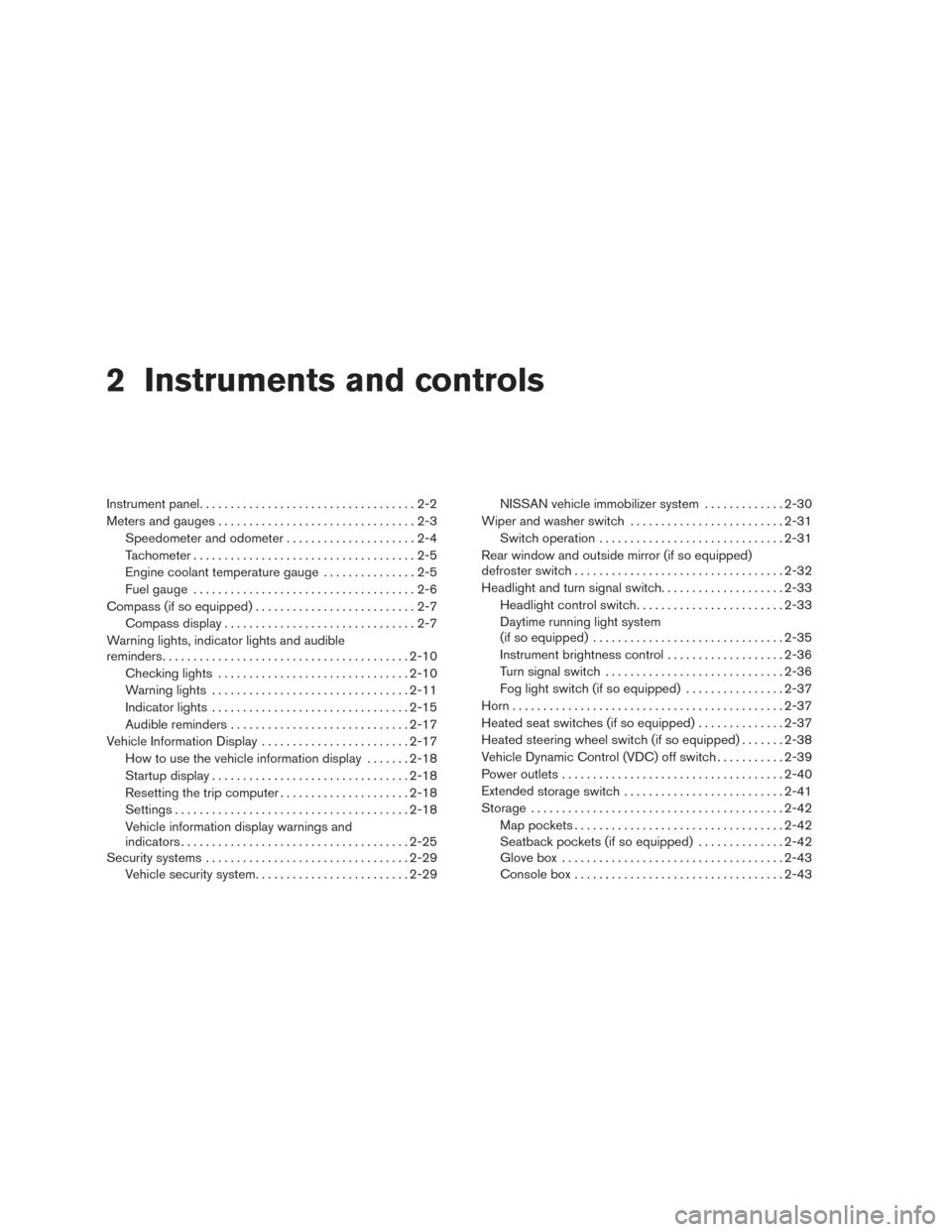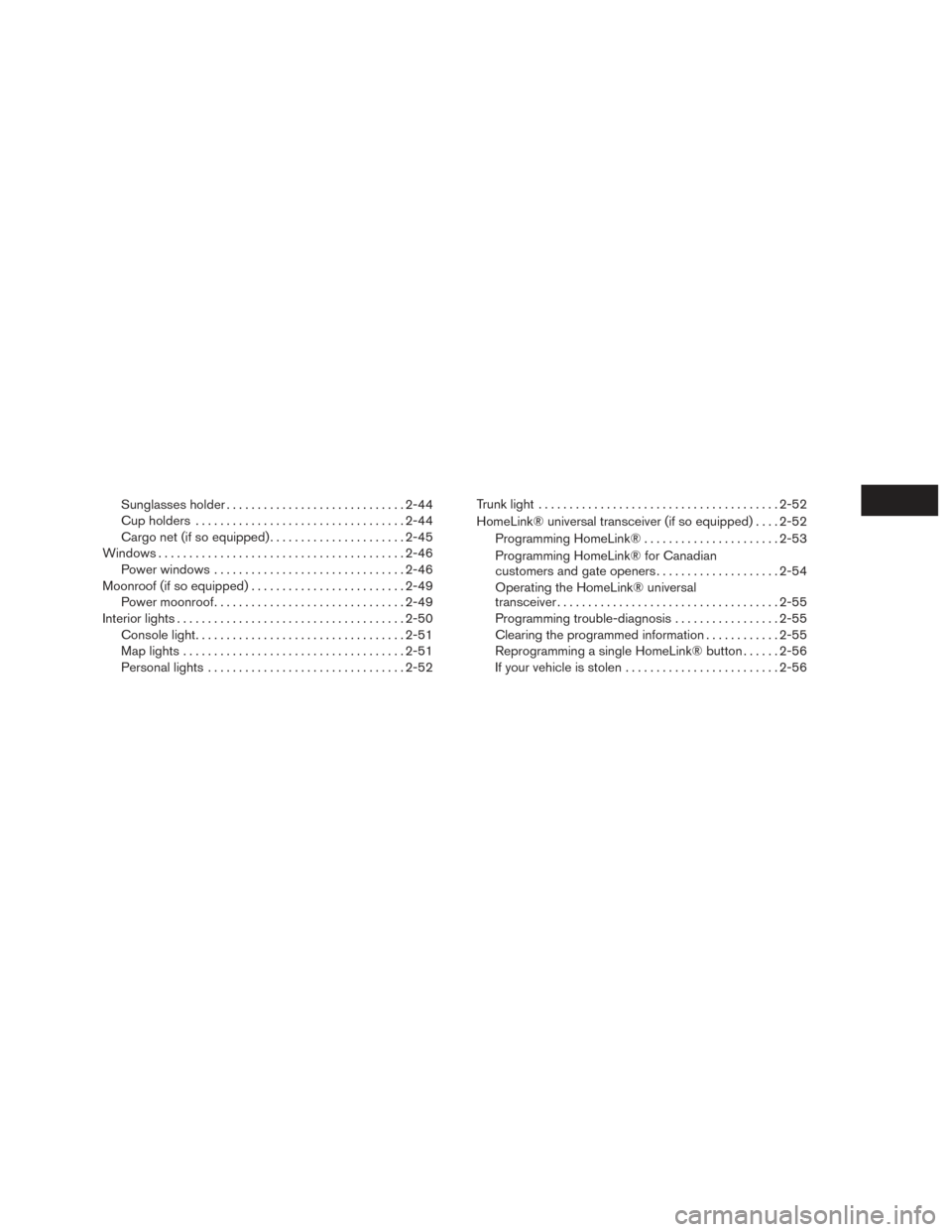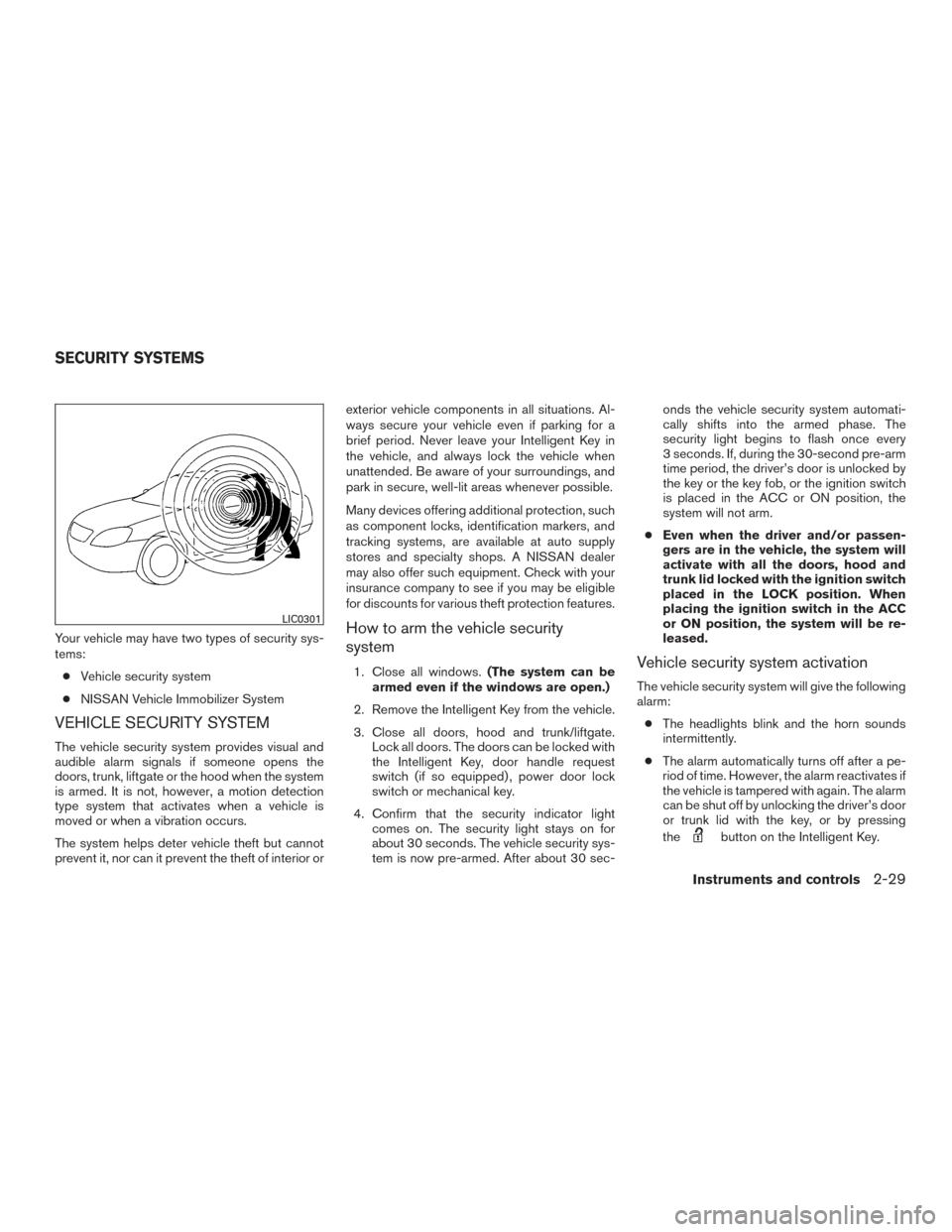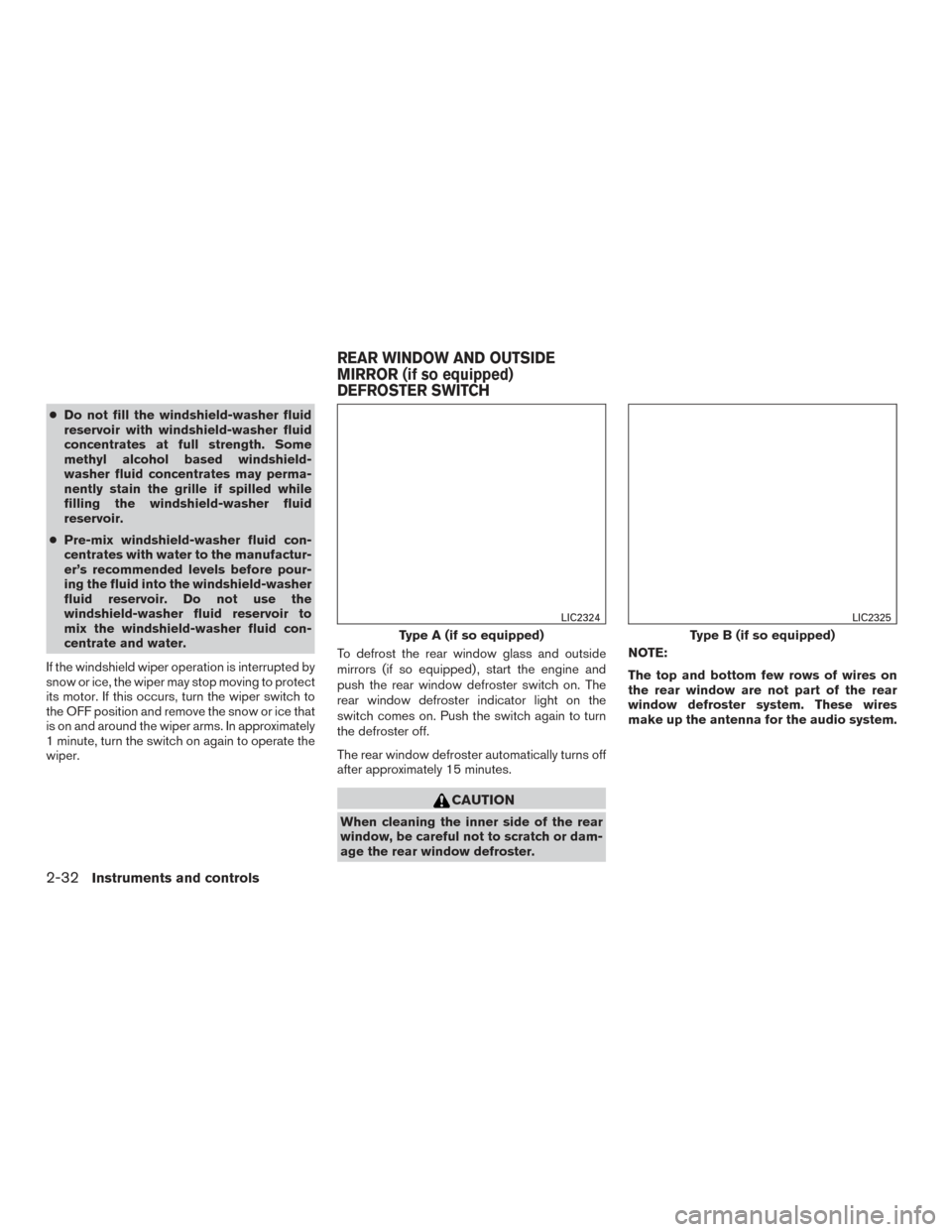Page 10 of 491
1. Power windows (P. 2-46)
2. Windshield (P. 8-23)
3. Wiper and washer switch (P. 2-31)
4. Engine hood (P. 3-29)
5. Fog light switch (if so equipped)(P. 2-33)
6. Headlight and turn signal switch
(P. 2-33)
Replacing bulbs (P. 8-29)
7. Tire pressure (P. 8-34) Flat tire (P. 6-3)
Tire chains (P. 8-34)
8. Mirrors (P. 3-36)
9. Door locks (P. 3-4) NISSAN Intelligent Key ® (P. 3-7, 3-20)
Keys (P. 3-2)
Refer to the page number indicated in pa-
rentheses for operating details.
LII2378
EXTERIOR FRONT
Illustrated table of contents0-3
Page 11 of 491
1. Rear window and outside mirror (if soequipped) defroster switch (P. 2-32)
2. Trunk lid (P. 3-30)
3. Rearview camera (if so equipped)
(P. 4-10)
4. Replacing bulbs (P. 8-29)
5. Fuel-filler cap (P. 3-32) Fuel recommendation (P. 9-2)
Fuel-filler door (P. 3-32)
6. Child safety rear door lock (P. 3-4)
Refer to the page number indicated in pa-
rentheses for operating details.
LII2379
EXTERIOR REAR
0-4Illustrated table of contents
Page 61 of 491
WARNING
●Never let children ride unrestrained or
extend their hands or face out of the
window. Do not attempt to hold them in
your lap or arms. Some examples of
dangerous riding positions are shown
in the illustrations.
ARS1133ARS1041
1-44Safety—Seats, seat belts and supplemental restraint system
** Click HERE to see "Owner's Manual Supplement" **
Page 64 of 491
WARNING
●The seat belts, the side air bags and
curtain air bags are most effective when
you are sitting well back and upright in
the seat with both feet on the floor. The
side air bag and curtain air bag inflate
with great force. Do not allow anyone to
place their hand, leg or face near the
side air bag on the side of the seatback
of the front seat or near the side roof
rails. Do not allow anyone sitting in the
front seats or rear outboard seats to
extend their hand out of the window or
lean against the door. Some examples
of dangerous riding positions are
shown in the previous illustrations.
SSS0162SSS0159
Safety—Seats, seat belts and supplemental restraint system1-47
** Click HERE to see "Owner's Manual Supplement" **
Page 79 of 491

2 Instruments and controls
Instrument panel...................................2-2
Meters and gauges ................................2-3
Speedometer and odometer .....................2-4
Tachometer ....................................2-5
Engine coolant temperature gauge ...............2-5
Fuel gauge ....................................2-6
Compass (if so equipped) ..........................2-7
Compass display ...............................2-7
Warning lights, indicator lights and audible
reminders ........................................ 2-10
Checking lights ............................... 2-10
Warning lights ................................ 2-11
Indicator lights ................................ 2-15
Audible reminders ............................. 2-17
Vehicle Information Display ........................2-17
How to use the vehicle information display .......2-18
Startup display ................................ 2-18
Resetting the trip computer .....................2-18
Settings ...................................... 2-18
Vehicle information display warnings and
indicators ..................................... 2-25
Security systems ................................. 2-29
Vehicle security system ......................... 2-29NISSAN vehicle immobilizer system
.............2-30
Wiper and washer switch ......................... 2-31
Switch operation .............................. 2-31
Rear window and outside mirror (if so equipped)
defroster switch .................................. 2-32
Headlight and turn signal switch ....................2-33
Headlight control switch ........................ 2-33
Daytime running light system
(if so equipped) ............................... 2-35
Instrument brightness control ...................2-36
Turn signal switch ............................. 2-36
Fog light switch (if so equipped) ................2-37
Horn ............................................ 2-37
Heated seat switches (if so equipped) ..............2-37
Heated steering wheel switch (if so equipped) .......2-38
Vehicle Dynamic Control (VDC) off switch ...........2-39
Power outlets .................................... 2-40
Extended
storage switch .......................... 2-41
Storage ......................................... 2-42
Map pockets .................................. 2-42
Seatback pockets (if so equipped) ..............2-42
Glove box .................................... 2-43
Console box .................................. 2-43
Page 80 of 491

Sunglasses holder............................. 2-44
Cup holders .................................. 2-44
Cargo net (if so equipped) ......................2-45
Windows ........................................ 2-46
Power windows ............................... 2-46
Moonroof (if so equipped) ......................... 2-49
Power moonroof ............................... 2-49
Interior lights ..................................... 2-50
Console light .................................. 2-51
Map lights .................................... 2-51
Personal lights ................................ 2-52Trunk light
....................................... 2-52
HomeLink® universal transceiver (if so equipped) ....2-52
Programming HomeLink® ......................2-53
Programming HomeLink® for Canadian
customers and gate openers ....................2-54
Operating the HomeLink® universal
transceiver .................................... 2-55
Programming trouble-diagnosis .................2-55
Clearing the programmed information ............2-55
Reprogramming a single HomeLink® button ......2-56
If your vehicle is stolen ......................... 2-56
Page 108 of 491

Your vehicle may have two types of security sys-
tems:● Vehicle security system
● NISSAN Vehicle Immobilizer System
VEHICLE SECURITY SYSTEM
The vehicle security system provides visual and
audible alarm signals if someone opens the
doors, trunk, liftgate or the hood when the system
is armed. It is not, however, a motion detection
type system that activates when a vehicle is
moved or when a vibration occurs.
The system helps deter vehicle theft but cannot
prevent it, nor can it prevent the theft of interior or exterior vehicle components in all situations. Al-
ways secure your vehicle even if parking for a
brief period. Never leave your Intelligent Key in
the vehicle, and always lock the vehicle when
unattended. Be aware of your surroundings, and
park in secure, well-lit areas whenever possible.
Many devices offering additional protection, such
as component locks, identification markers, and
tracking systems, are available at auto supply
stores and specialty shops. A NISSAN dealer
may also offer such equipment. Check with your
insurance company to see if you may be eligible
for discounts for various theft protection features.
How to arm the vehicle security
system
1. Close all windows.
(The system can be
armed even if the windows are open.)
2. Remove the Intelligent Key from the vehicle.
3. Close all doors, hood and trunk/liftgate. Lock all doors. The doors can be locked with
the Intelligent Key, door handle request
switch (if so equipped) , power door lock
switch or mechanical key.
4. Confirm that the security indicator light comes on. The security light stays on for
about 30 seconds. The vehicle security sys-
tem is now pre-armed. After about 30 sec- onds the vehicle security system automati-
cally shifts into the armed phase. The
security light begins to flash once every
3 seconds. If, during the 30-second pre-arm
time period, the driver’s door is unlocked by
the key or the key fob, or the ignition switch
is placed in the ACC or ON position, the
system will not arm.
● Even when the driver and/or passen-
gers are in the vehicle, the system will
activate with all the doors, hood and
trunk lid locked with the ignition switch
placed in the LOCK position. When
placing the ignition switch in the ACC
or ON position, the system will be re-
leased.Vehicle security system activation
The vehicle security system will give the following
alarm:
● The headlights blink and the horn sounds
intermittently.
● The alarm automatically turns off after a pe-
riod of time. However, the alarm reactivates if
the vehicle is tampered with again. The alarm
can be shut off by unlocking the driver’s door
or trunk lid with the key, or by pressing
the
button on the Intelligent Key.
LIC0301
SECURITY SYSTEMS
Instruments and controls2-29
Page 111 of 491

●Do not fill the windshield-washer fluid
reservoir with windshield-washer fluid
concentrates at full strength. Some
methyl alcohol based windshield-
washer fluid concentrates may perma-
nently stain the grille if spilled while
filling the windshield-washer fluid
reservoir.
● Pre-mix windshield-washer fluid con-
centrates with water to the manufactur-
er’s recommended levels before pour-
ing the fluid into the windshield-washer
fluid reservoir. Do not use the
windshield-washer fluid reservoir to
mix the windshield-washer fluid con-
centrate and water.
If the windshield wiper operation is interrupted by
snow or ice, the wiper may stop moving to protect
its motor. If this occurs, turn the wiper switch to
the OFF position and remove the snow or ice that
is on and around the wiper arms. In approximately
1 minute, turn the switch on again to operate the
wiper. To defrost the rear window glass and outside
mirrors (if so equipped) , start the engine and
push the rear window defroster switch on. The
rear window defroster indicator light on the
switch comes on. Push the switch again to turn
the defroster off.
The rear window defroster automatically turns off
after approximately 15 minutes.
CAUTION
When cleaning the inner side of the rear
window, be careful not to scratch or dam-
age the rear window defroster.NOTE:
The top and bottom few rows of wires on
the rear window are not part of the rear
window defroster system. These wires
make up the antenna for the audio system.
Type A (if so equipped)
LIC2324
Type B (if so equipped)
LIC2325
REAR WINDOW AND OUTSIDE
MIRROR (if so equipped)
DEFROSTER SWITCH
2-32Instruments and controls